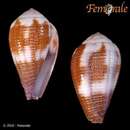fi
nimet breadcrumb-navigoinnissa


Conus coffeae, common name the coffee cone, is a species of sea snail, a marine gastropod mollusk in the family Conidae, the cone snails and their allies.[1]
Like all species within the genus Conus, these snails are predatory and venomous. They are capable of "stinging" humans, therefore live ones should be handled carefully or not at all.
The size of the shell varies between 18 mm and 51 mm. The yellowish brown shell is white-banded in the middle and less distinctly so at the shoulder and the base of the body whorl. These bands are sometimes maculated, like the spire, with chestnut, and there are, on the darker portions, occasional faint chestnut revolving lines.[2]
This marine species occurs in the Central and Western Pacific; off Australia (New South Wales, Northern Territory, Queensland, Western Australia)
Conus coffeae, common name the coffee cone, is a species of sea snail, a marine gastropod mollusk in the family Conidae, the cone snails and their allies.
Like all species within the genus Conus, these snails are predatory and venomous. They are capable of "stinging" humans, therefore live ones should be handled carefully or not at all.
Conus coffeae is een in zee levende slakkensoort uit het geslacht Conus. De slak behoort tot de familie Conidae. Conus coffeae werd in 1791 beschreven door Gmelin.[1] Net zoals alle soorten binnen het geslacht Conus zijn deze slakken roofzuchtig en giftig. Zij bezitten een harpoenachtige structuur waarmee ze hun prooi kunnen steken en verlammen.[2]
Conus coffeae é uma espécie de gastrópode do gênero Conus, pertencente a família Conidae. [1]
Conus coffeae là một loài ốc biển, là động vật thân mềm chân bụng sống ở biển trong họ Conidae, họ ốc cối.[1]
Giống như tất cả các loài thuộc chi Conus, chúng là loài săn mồi và có nọc độc. Chúng có khả năng "đốt" con người, do vậy khi cầm chúng phải hết sức cẩn thận.
Phương tiện liên quan tới Conus coffeae tại Wikimedia Commons
Conus coffeae là một loài ốc biển, là động vật thân mềm chân bụng sống ở biển trong họ Conidae, họ ốc cối.
Giống như tất cả các loài thuộc chi Conus, chúng là loài săn mồi và có nọc độc. Chúng có khả năng "đốt" con người, do vậy khi cầm chúng phải hết sức cẩn thận.
咖啡芋螺(学名:Conus coffeae)为芋螺科芋螺屬下的一个种。
|access-date=中的日期值 (帮助)